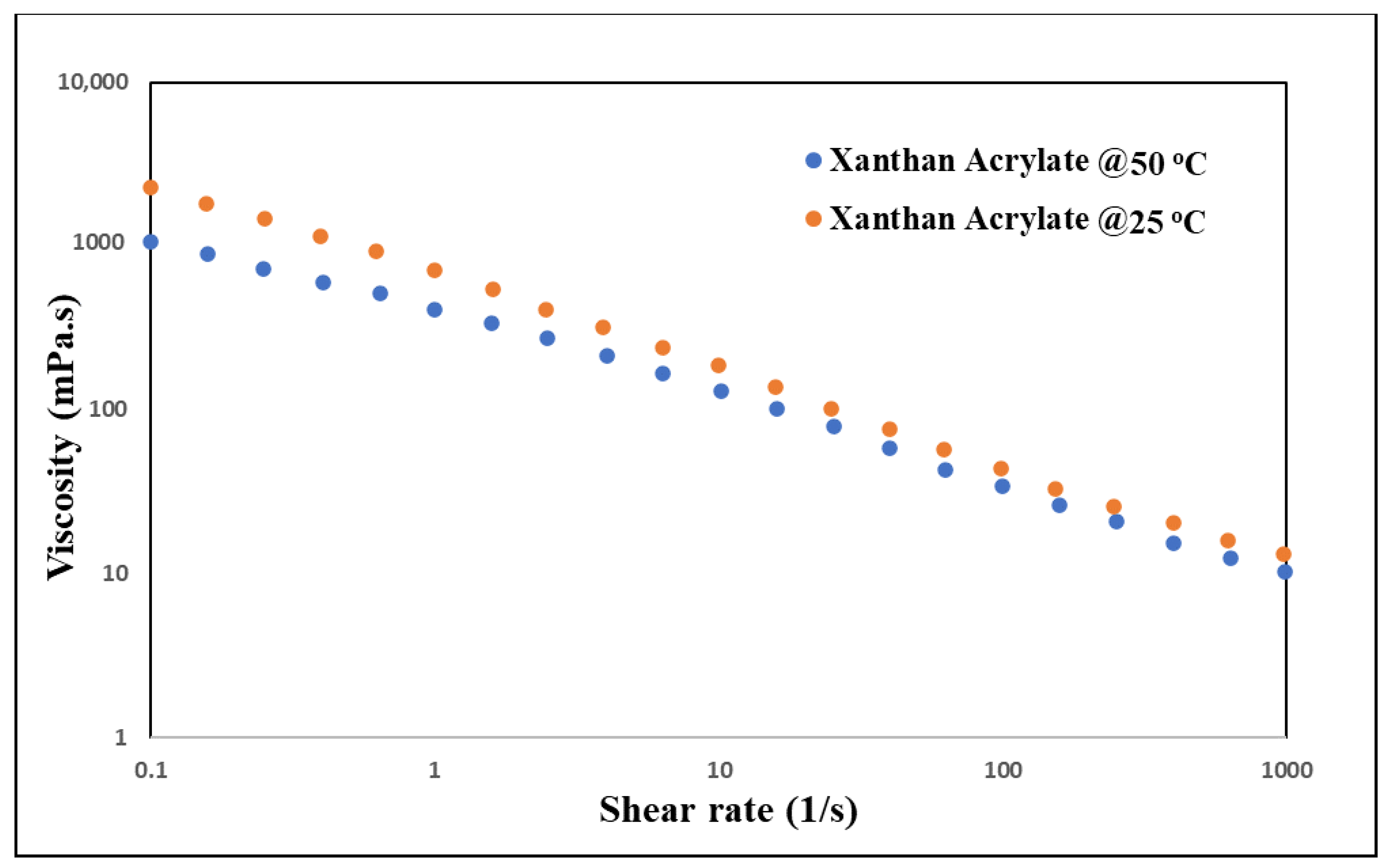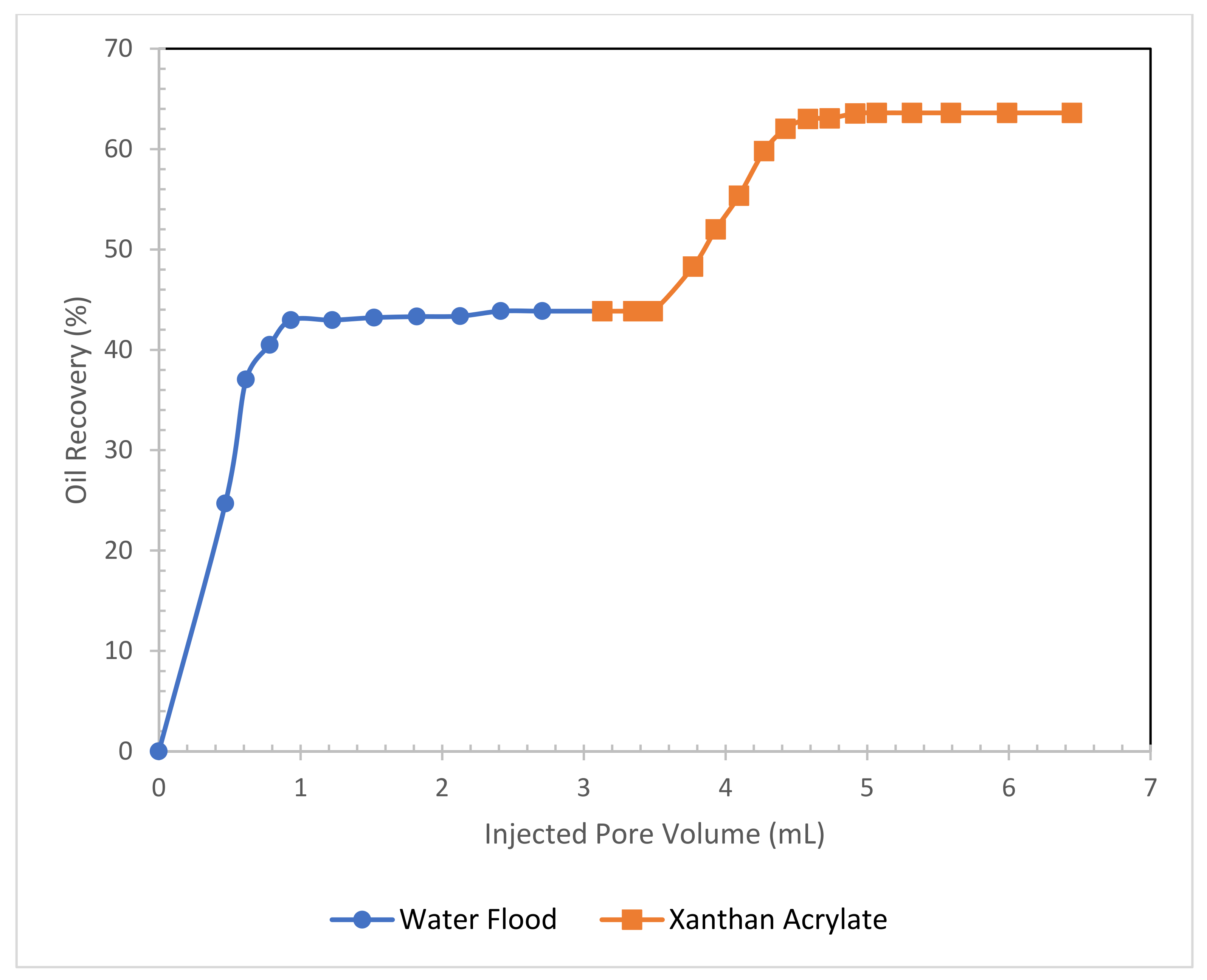Modification of Xanthan Gum for a High-Temperature and High-Salinity Reservoir
Abstract
:1. Introduction
- (1)
- Modify xanthan gum by adding acrylic acid;
- (2)
- Examine the modified xanthan gum’s chemical structure using FT-IR and NMR spectra;
- (3)
- Investigate the rheological properties of the xanthan gum and modified xanthan gum solutions at different temperatures to determine the level at which the synthesis process has been achieved;
- (4)
- Explore the relationship between the EOR performances of the xanthan and modified xanthan gums.
2. Methodology
2.1. Materials
2.1.1. Xanthan Gum
2.1.2. Acrylic Acid
2.1.3. Gluconic Acid
2.1.4. Polyvinyl Acetate
2.1.5. N-[3-(dimethyl aminopro-165 pyl)]-N-ethyl Carbodiimide Hydrochloride
2.2. XG Modification
2.2.1. Physical Blending
2.2.2. Chemical Modification
2.3. Rheological Property Measurements
2.4. FT-IR
2.5. Core Flooding Experiment
3. Results and Discussion
3.1. FT-IR and NMR Analysis
3.2. Rheological Property
3.2.1. Blending of XG with PVA, GA, and AA
3.2.2. Chemically Modified Xanthan Gum—Xanthan Acrylate
3.3. Core Flooding Results
3.3.1. Oil Recovery of the Xanthan Acrylate
3.3.2. Comparison of Pure Xanthan Gum and Xanthan Acrylate Recoveries
4. Conclusions
- (1)
- The FT-IR and NMR analyses showed that there was a successful chemical modification of the xanthan gum. The chemical structure of the xanthan gum was reformed after its reaction with acrylic acid. The FT-IR spectrum of the xanthan gum showed absorption peaks at 3277 cm−1. The FT-IR spectrum of the xanthan acrylate showed peaks identical to those of the xanthan gum. Moreover, a new peak appeared at 1645 cm−1.
- (2)
- The chemically modified xanthan gum demonstrated increased rheological properties, compared to the xanthan gum. The viscosity at a 0.1 s−1 shear rate and 25 °C was 578 mPa·s for the xanthan and 2200 mPa·s for the xanthan acrylate under the same experimental conditions. In addition, the stability in terms of viscosity of the xanthan gum increased with increasing temperatures.
- (3)
- The improvement of the xanthan gum’s viscosity after its modification was reflected in the oil recovered from the cores. The characteristics of the rocks were kept the same to allow for a reasonable comparison between the original and modified xanthan gums. The core flooding results also confirmed that the modified xanthan gum offered a higher rate of oil recovery, recovering more than 5% more of the IOIP compared to the pure xanthan gum due to the increased viscosity. The xanthan gum in combination with the 3% NaCl solution recovered about 45% of the oil as secondary oil and 14% as tertiary oil. The modified xanthan gum formulation produced about 44% of the oil as secondary oil and 19% as tertiary oil.
5. Recommendations
- (1)
- The proposed modification for xanthan gum should be tested on carbonate rock.
- (2)
- Further research should be conducted to identify other modified xanthan gums with increased concentrations of acrylic acid.
- (3)
- After many trials, the chemical reaction was successful because it was susceptible to temperature. Therefore, future work should take into consideration adjustments of the reaction temperature.
Supplementary Materials
Author Contributions
Funding
Institutional Review Board Statement
Informed Consent Statement
Data Availability Statement
Acknowledgments
Conflicts of Interest
References
- Sun, X.; Zhang, Y.; Chen, G.; Gai, Z. Application of Nanoparticles in Enhanced Oil Recovery: A Critical Review of Recent Progress. Energies 2017, 10, 345. [Google Scholar] [CrossRef] [Green Version]
- Cheraghian, G.; Hendraningrat, L. A review on applications of nanotechnology in the enhanced oil recovery part A: Effects of nanoparticles on interfacial tension. Int. Nano Lett. 2016, 6, 129–138. [Google Scholar] [CrossRef] [Green Version]
- Muhammed, N.S.; Haq, B.; Al-Shehri, D.; Rahaman, M.M.; Keshavarz, A.; Hossain, S.M.Z. Comparative Study of Green and Synthetic Polymers for Enhanced Oil Recovery. Polymers 2020, 12, 2429. [Google Scholar] [CrossRef] [PubMed]
- Deng, X.; Tariq, Z.; Murtaza, M.; Patil, S.; Mahmoud, M.; Kamal, M.S. Relative contribution of wettability Alteration and interfacial tension reduction in EOR: A critical review. J. Mol. Liq. 2021, 325, 115175. [Google Scholar] [CrossRef]
- Guo, Y.; Zhang, L.; Zhu, G.; Yao, J.; Sun, H.; Song, W.; Yang, Y.; Zhao, J. A Pore-Scale Investigation of Residual Oil Distributions and Enhanced Oil Recovery Methods. Energies 2019, 12, 3732. [Google Scholar] [CrossRef] [Green Version]
- Haq, B. Green Enhanced Oil Recovery for Carbonate Reservoirs. Polymers 2021, 13, 3269. [Google Scholar] [CrossRef] [PubMed]
- Haq, B. The Role of Microbial Products in Green Enhanced Oil Recovery: Acetone and Butanone. Polymers 2021, 13, 1946. [Google Scholar] [CrossRef]
- Haq, B.; Liu, J.; Liu, K.; Al Shehri, D. The role of biodegradable surfactant in microbial enhanced oil recovery. J. Pet. Sci. Eng. 2020, 189, 106688. [Google Scholar] [CrossRef]
- Al-Mjeni, R.; Arora, S.; Cherukupalli, P.; Van Wunnik, J.; Edwards, J.; Felber, B.J. Has the time come for EOR? Oilf. Rev. 2010, 22, 16–35. [Google Scholar]
- Kalam, S.; Abu-Khamsin, S.A.; Kamal, M.S.; Patil, S. A review on surfactant retention on rocks: Mechanisms, measurements, and influencing factors. Fuel 2021, 293, 120459. [Google Scholar] [CrossRef]
- Abhishek, R.; Hamouda, A.A. Effect of Various Silica Nanofluids: Reduction of Fines Migrations and Surface Modification of Berea Sandstone. Appl. Sci. 2017, 7, 1216. [Google Scholar] [CrossRef] [Green Version]
- Cheraghian, G.; Khalilinezhad, S.S.; Kamari, M.; Hemmati, M.; Masihi, M.; Bazgir, S. Adsorption polymer on reservoir rock and role of the nanoparticles, clay and SiO2. Int. Nano Lett. 2014, 4, 114. [Google Scholar] [CrossRef] [Green Version]
- Kamal, M.S.; Adewunmi, A.A.; Sultan, A.S.; Al-Hamad, M.F.; Mehmood, U. Recent Advances in Nanoparticles Enhanced Oil Recovery: Rheology, Interfacial Tension, Oil Recovery, and Wettability Alteration. J. Nanomater. 2017, 2017, 1–15. [Google Scholar] [CrossRef]
- Al Bahri, M.S.; Vazquez, O.; Beteta, A.; Al Kalbani, M.M.; Mackay, E.J. Modelling the Impact of Low Salinity Waterflooding, Polymer Flooding and Thermally Activated Polymer on Produced Water Composition. In Proceedings of the SPE International Oilfield Scale Conference and Exhibition, Virtuel, 24–25 June 2020. [Google Scholar] [CrossRef]
- Rellegadla, S.; Prajapat, G.; Agrawal, A. Polymers for enhanced oil recovery: Fundamentals and selection criteria. Appl. Microbiol. Biotechnol. 2017, 101, 4387–4402. [Google Scholar] [CrossRef]
- Firozjaii, A.M.; Saghafi, H.R. Review on chemical enhanced oil recovery using polymer flooding: Fundamentals, experimental and numerical simulation. Petroleum 2020, 6, 115–122. [Google Scholar] [CrossRef]
- Wever, D.; Picchioni, F.; Broekhuis, A. Polymers for enhanced oil recovery: A paradigm for structure–property relationship in aqueous solution. Prog. Polym. Sci. 2011, 36, 1558–1628. [Google Scholar] [CrossRef]
- Pu, W.; Shen, C.; Wei, B.; Yang, Y.; Li, Y. A comprehensive review of polysaccharide biopolymers for enhanced oil recovery (EOR) from flask to field. J. Ind. Eng. Chem. 2018, 61, 1–11. [Google Scholar] [CrossRef]
- Gbadamosi, A.O.; Junin, R.; Manan, M.A.; Agi, A.; Yusuff, A.S. An overview of chemical enhanced oil recovery: Recent advances and prospects. Int. Nano Lett. 2019, 9, 171–202. [Google Scholar] [CrossRef] [Green Version]
- Sathiyanarayanan, G.; Yi, D.-H.; Bhatia, S.K.; Kim, J.-H.; Seo, H.M.; Kim, Y.-G.; Park, S.-H.; Jeong, D.; Jung, S.; Jung, J.-Y.; et al. Exopolysaccharide from psychrotrophic Arctic glacier soil bacterium Flavobacterium sp. ASB 3-3 and its potential applications. RSC Adv. 2015, 5, 84492–84502. [Google Scholar] [CrossRef]
- Bhatia, S.K.; Gurav, R.; Choi, Y.-K.; Choi, T.-R.; Kim, H.-J.; Song, H.-S.; Lee, S.M.; Park, S.L.; Lee, H.S.; Kim, Y.-G.; et al. Bioprospecting of exopolysaccharide from marine Sphingobium yanoikuyae BBL01: Production, characterization, and metal chelation activity. Bioresour. Technol. 2021, 324, 124674. [Google Scholar] [CrossRef]
- Jouenne, S. Polymer flooding in high temperature, high salinity conditions: Selection of polymer type and polymer chemistry, thermal stability. J. Pet. Sci. Eng. 2020, 195, 107545. [Google Scholar] [CrossRef]
- Nasr, S.; Soudi, M.R.; Haghighi, M. Xanthan Production by a Native Strain of X. campestris and Evaluation of Application in EOR. Pak. J. Biol. Sci. 2007, 10, 3010–3013. [Google Scholar] [CrossRef]
- Becker, A.; Katzen, F.; Pühler, A.; Ielpi, L. Xanthan gum biosynthesis and application: A biochemical /genetic perspective. Appl. Microbiol. Biotechnol. 1998, 50, 145–152. [Google Scholar] [CrossRef]
- Xu, Z.; Zhu, L.; Chen, H. Acrylic Acid. Compr. Biotechnol. 2011, 3, 201–206. [Google Scholar] [CrossRef]
- Magdy, A.; Zahran, W.A.; Abd El-Mawgood, M.; Basuni, M. Poly Acrylic Acid: Synthesis, Aqueous Properties and their Applications as Scale Inhibitor. KGK Rubberpoint 2016, 69, 53–58. [Google Scholar]
- Florit, F.; Rodrigues Bassam, P.; Cesana, A.; Storti, G. Solution Polymerization of Acrylic Acid Initiated by Redox Couple Na-PS/Na-MBS: Kinetic Model and Transition to Continuous Process. Processes 2020, 8, 850. [Google Scholar] [CrossRef]
- Srivastava, A.; Kumar, R. Synthesis and Characterization of Acrylic Acid-g-(-Carrageenan) Copolymer and Study of Its Application. Int. J. Carbohydr. Chem. 2013, 2013, 1–8. [Google Scholar] [CrossRef]
- Yilmaz, S.S.; Yildirim, N.; Misir, M.; Misirlioglu, Y.; Celik, E. Synthesis, Characterization of a New Polyacrylic Acid Superabsorbent, Some Heavy Metal Ion Sorption, the Adsorption Isotherms, and Quantum Chemical Investigation. Materials 2020, 13, 4390. [Google Scholar] [CrossRef] [PubMed]
- Ramachandran, S.; Fontanille, P.; Pandey, A.; Larroche, C. Gluonic Acid: Properties, Applications, and Microbial Production. Food Technol. Biotechnol. 2006, 44, 185–195. [Google Scholar]
- Jamil, N.; Husin, H.; Alfida, A.W.; Aman, Z.; Hassan, Z. Characterization and Preparation of Polyvinyl Alcohol (PVA) as Inhibitor in Formation of Hydrates. Int. J. Curr. Res. Sci. Eng. Technol. 2018, 1, 578–584. [Google Scholar] [CrossRef]
- Chiellini, E.; Corti, A.; D’Antone, S.; Solaro, R. Biodegradation of poly (vinyl alcohol) based materials. Prog. Polym. Sci. 2003, 28, 963–1014. [Google Scholar] [CrossRef]
- Zanela, J.; Bilck, A.P.; Casagrande, M.; Grossmann, M.V.E.; Yamashita, F. Polyvinyl alcohol (PVA) molecular weight and extrusion temperature in starch/PVA biodegradable sheets. Polimeros 2018, 28, 256–265. [Google Scholar] [CrossRef]
- Ollivier, C. Bicyclic 5-5 Systems with One Bridgehead (Ring Junction) Nitrogen Atom: Two Extra Heteroatoms 1:1. In Comprehensive Heterocyclic Chemistry III; Elsevier: Amsterdam, The Netherlands, 2008; pp. 133–197. [Google Scholar]
- Wang, C.; Liu, P.; Wang, Y.; Yuan, Z.; Xu, Z. Experimental Study of Key Effect Factors and Simulation on Oil Displacement Efficiency for a Novel Modified Polymer BD-HMHEC. Sci. Rep. 2018, 8, 1–9. [Google Scholar] [CrossRef] [PubMed] [Green Version]







| Core Flooding | Xanthan Gum | Xanthan Acrylate |
|---|---|---|
| Polymer concentration (ppm) | 1500 | 1500 |
| Core length (inches) | 6.04 | 5.94 |
| Porosity | 19.58 | 19.78 |
| Permeability (md) | 102.66 | 107.30 |
| Swi% | 39.88 | 40.61 |
| Pore volume (cc) | 34.00 | 33.83 |
| Initial oil saturation% | 60.22 | 59.49 |
| No. of pore volumes injected | 3 | 3 |
| Initial oil volume (cc) | 20.5 | 20.25 |
| Residual oil after water flooding (cc) | 11.3 | 11.37 |
| Recovery% of IOIP after water flooding | 44.88 | 43.85 |
| Recovery% of IOIP after chemical flooding * | 13.93 | 19.21 |
| Recovery% of ROS by chemical flooding | 25.27 | 35.18 |
Publisher’s Note: MDPI stays neutral with regard to jurisdictional claims in published maps and institutional affiliations. |
© 2021 by the authors. Licensee MDPI, Basel, Switzerland. This article is an open access article distributed under the terms and conditions of the Creative Commons Attribution (CC BY) license (https://creativecommons.org/licenses/by/4.0/).
Share and Cite
Said, M.; Haq, B.; Al Shehri, D.; Rahman, M.M.; Muhammed, N.S.; Mahmoud, M. Modification of Xanthan Gum for a High-Temperature and High-Salinity Reservoir. Polymers 2021, 13, 4212. https://doi.org/10.3390/polym13234212
Said M, Haq B, Al Shehri D, Rahman MM, Muhammed NS, Mahmoud M. Modification of Xanthan Gum for a High-Temperature and High-Salinity Reservoir. Polymers. 2021; 13(23):4212. https://doi.org/10.3390/polym13234212
Chicago/Turabian StyleSaid, Mohamed, Bashirul Haq, Dhafer Al Shehri, Mohammad Mizanur Rahman, Nasiru Salahu Muhammed, and Mohamed Mahmoud. 2021. "Modification of Xanthan Gum for a High-Temperature and High-Salinity Reservoir" Polymers 13, no. 23: 4212. https://doi.org/10.3390/polym13234212
APA StyleSaid, M., Haq, B., Al Shehri, D., Rahman, M. M., Muhammed, N. S., & Mahmoud, M. (2021). Modification of Xanthan Gum for a High-Temperature and High-Salinity Reservoir. Polymers, 13(23), 4212. https://doi.org/10.3390/polym13234212







